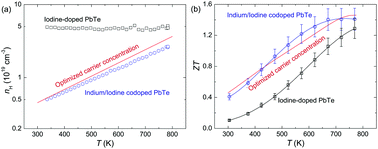当前位置:
X-MOL 学术
›
Energy Environ. Sci.
›
论文详情
Our official English website, www.x-mol.net, welcomes your
feedback! (Note: you will need to create a separate account there.)
Deep defect level engineering: a strategy of optimizing the carrier concentration for high thermoelectric performance†
Energy & Environmental Science ( IF 32.4 ) Pub Date : 2018-02-22 00:00:00 , DOI: 10.1039/c8ee00112j Qian Zhang 1, 2, 3, 4 , Qichen Song 5, 6, 7, 8 , Xinyu Wang 1, 2, 3, 4 , Jingying Sun 8, 9, 10, 11 , Qing Zhu 8, 9, 10, 11 , Keshab Dahal 8, 9, 10, 11 , Xi Lin 1, 2, 3, 4 , Feng Cao 3, 4, 12 , Jiawei Zhou 5, 6, 7, 8 , Shuo Chen 8, 9, 10, 11 , Gang Chen 5, 6, 7, 8 , Jun Mao 8, 9, 10, 11 , Zhifeng Ren 8, 9, 10, 11
Energy & Environmental Science ( IF 32.4 ) Pub Date : 2018-02-22 00:00:00 , DOI: 10.1039/c8ee00112j Qian Zhang 1, 2, 3, 4 , Qichen Song 5, 6, 7, 8 , Xinyu Wang 1, 2, 3, 4 , Jingying Sun 8, 9, 10, 11 , Qing Zhu 8, 9, 10, 11 , Keshab Dahal 8, 9, 10, 11 , Xi Lin 1, 2, 3, 4 , Feng Cao 3, 4, 12 , Jiawei Zhou 5, 6, 7, 8 , Shuo Chen 8, 9, 10, 11 , Gang Chen 5, 6, 7, 8 , Jun Mao 8, 9, 10, 11 , Zhifeng Ren 8, 9, 10, 11
Affiliation

|
Thermoelectric properties are heavily dependent on the carrier concentration, and therefore the optimization of carrier concentration plays a central role in achieving high thermoelectric performance. The optimized carrier concentration is highly temperature-dependent and could even possibly vary within one order of magnitude in the temperature range of several hundreds of Kelvin. Practically, however, the traditional doping strategy will only lead to a constant carrier concentration, and thus the thermoelectric performance is only optimized within a limited temperature range. Here, we demonstrate that a temperature-dependent carrier concentration can be realized by simultaneously introducing shallow and deep defect levels. In this work, iodine (I) and indium (In) are co-doped in PbTe, where iodine acts as the shallow donor level that supplies sufficient electrons and indium builds up the localized half-filled deep defect state in the band gap. The indium deep defect state traps electrons at a lower temperature and the trapped electrons will be thermally activated back to the conduction band when the temperature rises. In this way, the carrier concentration can be engineered as temperature-dependent, which matches the theoretically predicted optimized carrier concentration over the whole temperature range. As a result, a room temperature ZT of ∼0.4 and a peak ZT of ∼1.4 at 773 K were obtained in the n-type In/I co-doped PbTe, leading to a record-high average ZT of ∼1.04 in the temperature range of 300 to 773 K. Importantly, since deep defect levels also exist in other materials, the strategy of deep defect level engineering should be widely applicable to a variety of materials for enhancing the thermoelectric performance across a broad temperature range.
中文翻译:

深度缺陷级别工程:优化载流子浓度以实现高热电性能的策略†
热电性质在很大程度上取决于载流子浓度,因此载流子浓度的优化在实现高热电性能中起着核心作用。优化的载流子浓度高度依赖于温度,在数百开尔文的温度范围内甚至可能在一个数量级内变化。然而,实际上,传统的掺杂策略将仅导致恒定的载流子浓度,因此仅在有限的温度范围内优化热电性能。在这里,我们证明了可以通过同时引入浅和深缺陷水平来实现与温度有关的载流子浓度。在这项工作中,碘(I)和铟(In)共掺杂在PbTe中,其中碘充当提供足够电子的浅施主能级,铟则在带隙中建立局部的半填充深缺陷状态。铟深缺陷状态在较低的温度下捕获电子,并且当温度升高时,捕获的电子将被热激活回到导带。这样,可以将载流子浓度设计为与温度有关的温度,这与理论上预测的整个温度范围内的最佳载流子浓度相匹配。结果是室温 载流子浓度可以根据温度进行设计,这与在整个温度范围内理论上预测的优化载流子浓度相匹配。结果是室温 载流子浓度可以根据温度进行设计,这与在整个温度范围内理论上预测的优化载流子浓度相匹配。结果是室温ZT的〜0.4和峰值ZT在773的K〜1.4在n型In / I共掺杂的PbTe获得,导致一个记录高平均ZT的~1.04的温度范围内的300至773 K.重要的是,由于其他材料中也存在深缺陷水平,因此深缺陷水平工程设计策略应广泛适用于多种材料,以在较宽的温度范围内增强热电性能。
更新日期:2018-02-22
中文翻译:

深度缺陷级别工程:优化载流子浓度以实现高热电性能的策略†
热电性质在很大程度上取决于载流子浓度,因此载流子浓度的优化在实现高热电性能中起着核心作用。优化的载流子浓度高度依赖于温度,在数百开尔文的温度范围内甚至可能在一个数量级内变化。然而,实际上,传统的掺杂策略将仅导致恒定的载流子浓度,因此仅在有限的温度范围内优化热电性能。在这里,我们证明了可以通过同时引入浅和深缺陷水平来实现与温度有关的载流子浓度。在这项工作中,碘(I)和铟(In)共掺杂在PbTe中,其中碘充当提供足够电子的浅施主能级,铟则在带隙中建立局部的半填充深缺陷状态。铟深缺陷状态在较低的温度下捕获电子,并且当温度升高时,捕获的电子将被热激活回到导带。这样,可以将载流子浓度设计为与温度有关的温度,这与理论上预测的整个温度范围内的最佳载流子浓度相匹配。结果是室温 载流子浓度可以根据温度进行设计,这与在整个温度范围内理论上预测的优化载流子浓度相匹配。结果是室温 载流子浓度可以根据温度进行设计,这与在整个温度范围内理论上预测的优化载流子浓度相匹配。结果是室温ZT的〜0.4和峰值ZT在773的K〜1.4在n型In / I共掺杂的PbTe获得,导致一个记录高平均ZT的~1.04的温度范围内的300至773 K.重要的是,由于其他材料中也存在深缺陷水平,因此深缺陷水平工程设计策略应广泛适用于多种材料,以在较宽的温度范围内增强热电性能。











































 京公网安备 11010802027423号
京公网安备 11010802027423号